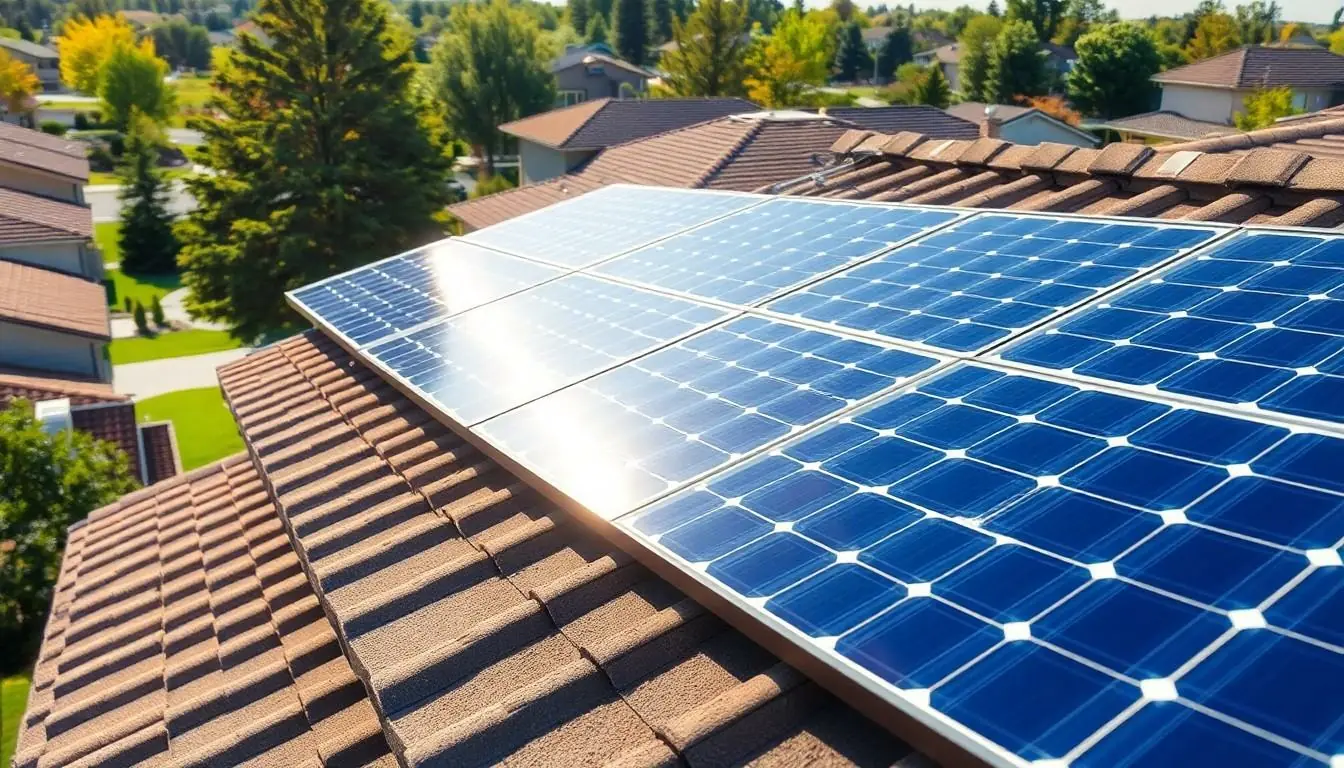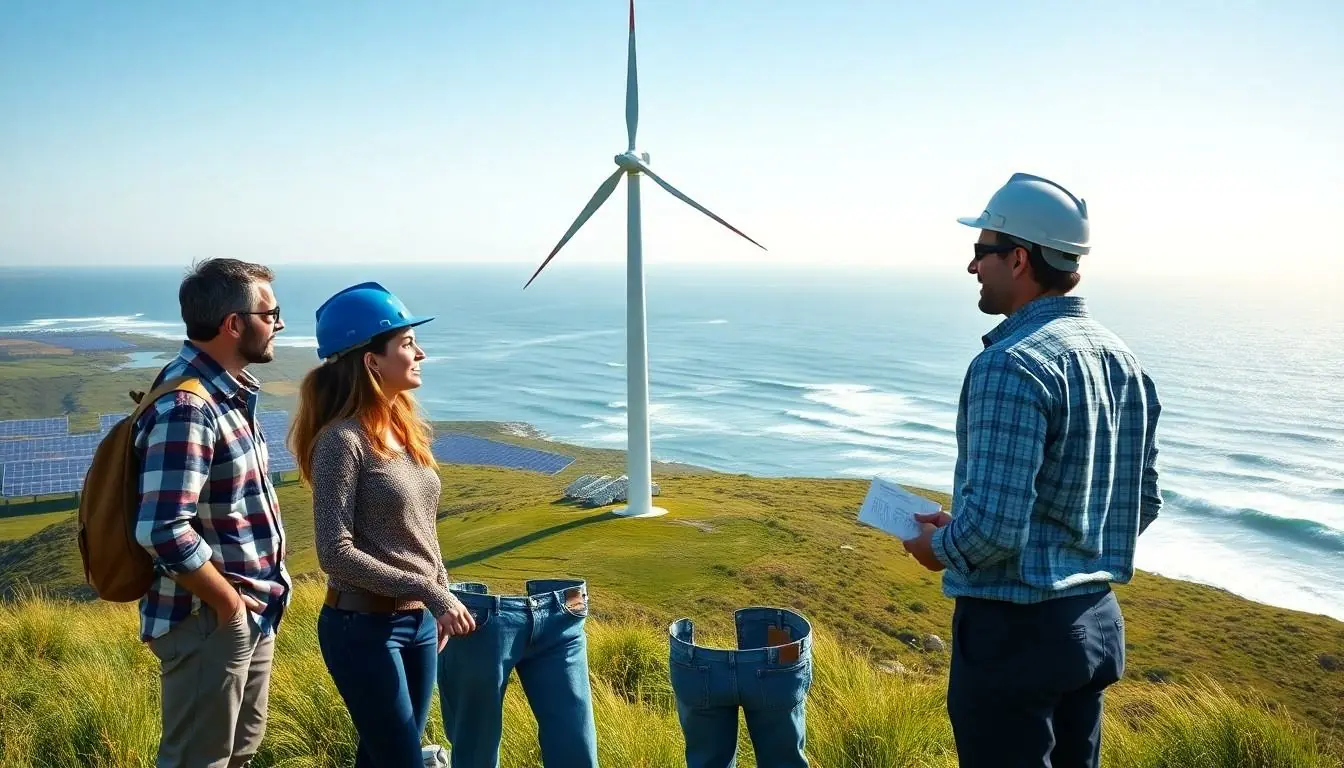The future of energy is here, and it’s not just solar panels and wind turbines anymore. Innovations in renewable energy sources are sprouting up faster than a toddler can say “eco-friendly.” From harnessing the power of ocean waves to turning trash into treasure, the world is buzzing with exciting breakthroughs that promise to reshape how we think about energy.
Table of Contents
ToggleOverview of Renewable Energy Sources
Renewable energy sources play a significant role in global efforts to reduce carbon emissions. Solar power captures sunlight using photovoltaic cells and converts it into electricity. Wind energy harnesses airflow through turbines, generating power efficiently across landscapes.
Hydropower utilizes flowing or falling water to create energy, often seen in dams. Biomass energy transforms organic materials into fuel, including wood, agricultural crops, and waste products. Geothermal energy taps into heat from the Earth’s interior, providing a steady energy supply.
Ocean energy sources include tidal power and wave energy. Tidal power exploits the gravitational pull of the moon and sun to create energy, while wave energy converts surface wave motion into usable electricity. Each of these sources has unique advantages, contributing to a diverse energy portfolio.
The world is increasingly shifting towards these renewable sources, achieving sustainability goals while addressing energy security. Innovations enhance the efficiency and viability of these methods, making them more accessible across various regions. Emerging technologies in solar panels and wind turbines improve their effectiveness, allowing for a greater energy yield.
Moreover, integration of smart grids with renewable sources optimizes energy distribution. These grids facilitate real-time monitoring, ensuring efficient energy use according to demand. Renewable energy sources not only help combat climate change but also foster economic growth by creating jobs in new energy sectors.
Research continues to drive advancements in energy storage solutions as well. Improved battery technologies increase the reliability of renewable systems, making them more competitive with traditional energy sources.
Key Innovations in Solar Energy

Innovations in solar energy continuously reshape the landscape of renewable energy, maximizing efficiency and accessibility. New technologies enhance the effectiveness of solar power systems, driving momentum in sustainable energy initiatives.
Photovoltaic Technology Advancements
Innovations in photovoltaic cells significantly increase energy conversion rates. Perovskite solar cells demonstrate remarkable potential, offering efficiencies exceeding 25 percent. Additionally, bifacial solar panels capture sunlight from both sides, optimizing energy collection. Flexible solar panels also emerge as a game-changer, allowing integration into various surfaces, such as windows and vehicles. These advancements aim to reduce costs while increasing the lifespan of solar technologies, making them more competitive against traditional energy sources.
Solar Thermal Energy Innovations
New developments in solar thermal energy focus on improving heat capture and storage. Concentrated solar power systems utilize mirrors to concentrate sunlight, generating high temperatures that produce steam to drive turbines. Innovations in thermal energy storage enable facilities to maintain energy production even during cloudy periods. Researchers explore materials such as phase change materials for better heat retention. These innovations lead to greater efficiency in energy use, making solar thermal systems a viable alternative to conventional energy sources.
Breakthroughs in Wind Energy
Innovations in wind energy are reshaping the landscape of renewable resources, enhancing efficiency and performance.
Turbine Design Improvements
Design advancements in turbines significantly boost energy capture. Larger rotor diameters allow for greater swept areas, thus increasing wind energy potential. Aerodynamic blade designs reduce drag and enable turbines to operate efficiently at lower wind speeds. Materials science plays a pivotal role as lighter, stronger materials enhance durability and longevity. Vertical-axis turbines are gaining popularity for their compact designs, making them suitable for urban settings. Continuous research optimizes these designs, ensuring turbines can harness wind energy more effectively across various environments.
Offshore Wind Energy Developments
Offshore wind energy projects are expanding at an impressive rate. Floating wind turbines enable operations in deeper waters, where wind conditions are often more favorable. These innovative platforms support larger turbine installations, allowing for increased power generation capacity. Studies indicate that offshore wind farms can produce higher energy yields due to consistent wind flows. Integrating advanced monitoring technologies enhances operational efficiency by allowing real-time performance tracking. Recent collaborations among companies and governments are crucial for developing infrastructure and technology, ensuring that offshore wind energy becomes a substantial part of overall renewable energy strategies.
Innovations in Hydropower
Hydropower continues to evolve, offering solutions that adapt to modern energy needs while addressing environmental concerns.
Small-Scale Hydropower Solutions
Small-scale hydropower projects harness energy from rivers and streams, enabling local communities to produce electricity sustainably. Utilization of these systems reduces reliance on large dams, mitigating disruption to ecosystems. Efficient designs, like micro-hydropower systems, generate power for remote areas without connecting to the grid. These systems typically have lower environmental footprints compared to traditional hydropower plants. With advancements in turbine technology, including cross-flow and Archimedes screw designs, small-scale installations produce energy effectively at lower flow rates. Several countries, such as Nepal and Peru, witness growing adoption of these solutions, enhancing energy access and fostering economic development.
Environmental Impact Mitigation Techniques
Innovations in hydropower include improved strategies for minimizing environmental impact. Techniques such as fish-friendly turbines reduce risks to aquatic life, ensuring fish populations thrive alongside energy generation. Creation of fish passages allows safe migration paths for species affected by dams. Monitoring technologies track water quality and aquatic ecosystems, enabling swift responses to potential issues. In addition, sediment management techniques maintain river health and functionality, preventing sediment buildup that can impair water flow. Environmental flow regulations guarantee ecosystems receive adequate water levels, promoting biodiversity and ecosystem resilience. As these techniques evolve, they align hydropower operations with sustainability goals while fulfilling energy demands.
Emerging Technologies in Bioenergy
Bioenergy is experiencing significant innovation, particularly through algal biofuels and waste-to-energy systems. These advancements showcase the potential of bioenergy to contribute meaningfully to renewable energy goals.
Algal Biofuels
Algal biofuels represent a promising energy source derived from algae. Algae can grow rapidly and require minimal resources, allowing for efficient fuel production. Recent advancements focus on optimizing algal strains to enhance oil yield. Researchers have developed bioreactors that maximize sunlight exposure, improving photosynthesis rates. Furthermore, cultivating algae on non-arable land prevents competition for agricultural resources. The reduction of CO2 emissions during the growth process highlights how algal biofuels can combat climate change. This emerging sector not only provides renewable fuel options but also contributes to sustainable practices in energy production.
Waste-to-Energy Innovations
Waste-to-energy innovations transform municipal waste into usable energy, addressing two pressing concerns: waste management and energy generation. Modern technologies like anaerobic digestion convert organic waste into biogas, a valuable fuel source. Recent developments in gasification further enhance energy extraction from waste materials through thermal decomposition, producing syngas for electricity. Advanced sorting systems also improve the efficiency of extracting recyclable materials, thus minimizing landfill use. Innovations in this area contribute to reduced greenhouse gas emissions by diverting waste from landfills. The integration of waste-to-energy systems into the energy grid promotes a circular economy, providing alternative energy sources while tackling waste issues.
The Role of Energy Storage Solutions
Energy storage solutions play a crucial role in maximizing the efficiency of renewable energy sources. Batteries, particularly lithium-ion technologies, enhance the reliability of solar and wind power. These systems store excess energy generated during peak production times for use during periods of low generation, ensuring a consistent energy supply.
Advancements in battery technology continue to lower costs and improve performance. Solid-state batteries represent a promising innovation, offering higher energy densities and increased safety. Flow batteries provide another alternative, allowing for long-duration energy storage suited to balancing supply and demand in grid applications.
Beyond batteries, other storage methods like pumped hydro storage and compressed air energy storage are gaining attention. Pumped hydro storage involves moving water between two reservoirs at different elevations, generating electricity during high-demand periods. Compressed air energy storage employs air compression to store energy in underground caverns, releasing it to generate power when needed.
Integrating energy storage with smart grids enhances system efficiency and optimizes energy management. Smart technology enables real-time data monitoring, allowing for better demand response and energy distribution strategies. This connection between energy storage and grid technology supports a more resilient and flexible energy infrastructure.
Policies promoting energy storage development will contribute to the global transition toward renewable energy. Regulations focused on reducing barriers to entry and incentivizing innovation in energy storage solutions encourage market participation. Collaborative efforts among governments, businesses, and research institutions foster innovation that drives efficiency and effectiveness in energy storage technologies.
These innovations position energy storage as a vital component of a sustainable energy future. They not only support the integration of variable renewable sources but also enhance energy security and emissions reduction goals. With ongoing advancements in energy storage solutions, the future of renewable energy becomes increasingly optimistic.
The future of renewable energy is bright with a multitude of innovative technologies reshaping the landscape. As advancements continue in solar, wind, hydropower, and bioenergy, the potential for sustainable energy solutions grows exponentially. These innovations not only enhance efficiency but also address environmental concerns and promote economic growth.
Energy storage solutions play a pivotal role in this transition by ensuring reliability and optimizing energy management. With collaborative efforts among governments and industries, the shift toward renewable sources is not just a possibility but an inevitable reality. Embracing these innovations will pave the way for a cleaner and more sustainable energy future.





